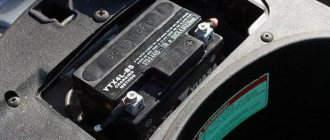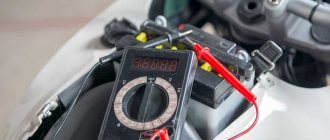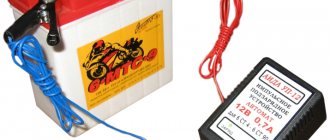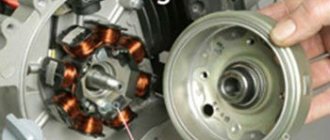Life rushes us more and more. Moving around the area, even in small towns, not to mention big cities and metropolitan areas, is getting faster and faster. Everyone chooses wheeled vehicles according to their taste and family characteristics, both financial and physical. The number of people who choose to travel on two-wheeled motor vehicles is growing significantly every year. And the largest percentage of this equipment is scooters. They have a number of advantages over their larger counterparts in the form of a moped and a motorcycle. Well, and accordingly, an even greater advantage over its brother in the form of a bicycle. Changing from a bike to a scooter will not be difficult. The weight of the most common scooter model ranges from 60 kilograms, so keeping balance with it is not difficult.
How to charge a gel battery for a moped without special charging
A couple of years after purchasing a moped, it becomes necessary to recharge the battery.
And then it turns out that the battery belongs to the category of gel batteries, for which not all chargers are suitable. How to restore battery capacity if a special charger is not at hand? Is there an alternative to special memory devices? The gel battery does not tolerate overdischarge, as a result of which the gel melts and turns into liquid. For this reason, devices capable of charging a lead or AKB battery for a moped are not suitable for recharging. These options have too high current and voltage ratings.
You need special chargers with automatic adjustment of the charging current, which are quite difficult to find on sale. The voltage of a suitable charger does not exceed 14 V, and the upper current threshold corresponds to 1/10 of the battery capacity (for 50 Ah - 5 A, for 7 Ah - 0.7 A). In this case, the device determines the charging time and turns off automatically when the battery is fully charged.
As an alternative to special chargers, you can use conventional chargers with a low charge current (for example, 0.5 A) and an output voltage of 12 V, which are suitable for recharging batteries with a capacity of 5 Ah or more. In this case, it is important to turn off charging in time to prevent the battery from heating up.
To determine the duration of the procedure, it is worth dividing the battery capacity by the current strength (for a 5 Ah battery and a 0.5 A charger, the charging time will be 10 hours). It is also important to periodically check the voltage on the gel battery using a tester: it should not exceed 14 V.
“Folk” method of recharging a gel battery If a gel battery needs urgent recharging, and you have not yet managed to find and order a special charger, use a simple trick. To implement this method, you will need a lead or AKB battery (for example, such as on the page https://www.bezpeka-hop.com/catalog/akkumulyatory_dlya_mopedov/) and charging from it. In this case, the second battery will be used as an “intermediary”.
The charging circuit through the second power source is as follows:
- connect the charger to the lead battery;
- connect the terminals of the lead battery to the contacts of the gel battery;
- check the temperature of the battery case; if it gets hot, stop the process;
- check the voltage (no more than 14 V).
The duration of the procedure depends on the battery capacity. Completely discharged moped batteries can be left to recharge for a day. In this case, it is necessary to monitor the process every 3–4 hours (check temperature and voltage).
It is worth using “folk” methods of restoring battery capacity only in extreme cases, since there is a risk of damaging the battery. It is not recommended to carry out these manipulations without control devices.
JavaScript is disabled in your browser
The scooter's generator is a key component of the entire electrical system of the scooter, because it is it that generates the electricity necessary for its operation. Modern scooters are equipped with many different devices and components that consume electricity. Thus, the scooter’s generator ensures the operation of the headlights, ignition system, dimensions, etc. In addition, the scooter's generator also charges the battery, which in turn powers the electric starter when starting the engine.
The principle of operation of a scooter generator is extremely simple; at its core, it is the most ordinary Magdino with a flywheel. Magdino (magneto plus dynamo machine) differs from a simple magneto in that it has two windings installed on it, which differ in voltage, while a magneto has only one winding installed. Installing two windings instead of one significantly reduces the load on the system and thereby increases its reliability and service life. So the high-voltage winding generates electricity, which is used to operate the scooter’s ignition system, while the low-voltage winding, which is also often called an inductance coil or a “light” coil, ensures the operation of headlights, dimensions, battery charging, etc. The voltage of the coil depends on the number of turns in the winding; the more turns, the higher the voltage.
The generation of electricity itself occurs due to electromagnetic induction. The crankshaft rotates a flywheel with permanent magnets around the coils, as a result of which the magnetic field inside the windings changes all the time and thus the required voltage is inducted. Interestingly, since the scooter's generator is a magdino, the magnetic armatures around the ignition winding and the light winding can even rotate at different speeds. Around the ignition coil directly on the crankshaft, and around the light coil through a special gear “raise”.
As you might have guessed, a scooter's generator can only produce alternating current. While many devices require direct current to operate. In particular, the battery can only be charged from constant voltage.
In short, direct current is a simple directional flow of electrons that moves from one pole to the other, while in alternating current the electrons constantly change direction. In order to convert alternating current into direct current, special diode rectifiers are used on the scooter. Roughly speaking, a diode allows electrons to flow in only one direction, thus converting alternating current into direct current. Thanks to diode rectifiers, a scooter generator can power any device, regardless of what type of current the device needs.
Video: #16 Replacing the relay regulator on an alpha moped.
How to charge a gel battery for a scooter
In many ways, a scooter's gel battery is noticeably superior to conventional lead-acid batteries. Due to the thick consistency of its electrolyte, such a battery can be installed at a strong angle (but not upside down), and it is not afraid of vibrations. In addition, the gel battery maintains a consistently high current in the circuit, continues to operate efficiently even at a low charge level, and also has a noticeably longer service life. In addition, the choice of gel batteries is now quite good.
But, due to the fact that this technology is relatively new, many owners of motorcycles, scooters and atvs are wondering before purchasing them: is it possible to charge a gel battery? We answer this question quite confidently – it is possible and even necessary. Moreover, with proper use, one high-quality branded gel battery can withstand up to 1000 recharges. However, we should not forget that gel batteries differ markedly from lead-acid batteries in their operating principle. Therefore, their operation and charging procedure are somewhat different from what we are used to.
Benefits with Sunwheel
Our service center offers restoration of the hoverboard battery. Here you will find a selection of components in the online catalog, prompt repairs and a quality guarantee. We provide our customers with the following benefits:
- reliability of work;
- selection of original spare parts;
- attractive terms of cooperation;
- low cost.
Our technicians will help you select batteries for a specific model and quickly replace them. Leave a request for purchase and repair, call 3 in Moscow, St. Petersburg or a toll-free number.
Gel battery: charging and maintenance
There are 2 basic rules for using a gel scooter battery:
- It should not be allowed to completely discharge. It is necessary to infect while the battery is still “alive”, otherwise you risk significantly “undermining” its volume. Gel batteries provide amazing efficiency even at a charge level of 20-30%, so you will always have time to get to the recharging point.
- You should always monitor the charge level of your gel battery. This is done using a multimeter, a special device for measuring voltage in various devices. If you decide to buy a gel battery, you should also consider purchasing a multimeter.
Direct charging of the gel battery should only be carried out with a special charger for 12V gel batteries. Don't try to make this a car charger! This is almost guaranteed death for a gel battery.
During the charging process, the most important thing is to monitor the voltage supplied to the battery. The charging voltage of the gel battery from the charger should not exceed the threshold (most often it is 14.2-14.4 V). If this rule is violated, the gel-like electrolyte will begin to turn into a gaseous state and evaporate. And replenishment of the electrolyte volume in the gel battery is not provided.
You can charge batteries anywhere. The main thing is to ensure uninterrupted power supply to the device. It is recommended to carry out this procedure at least once a season.
Why is the battery not charging?
The battery may not charge as a result of:
- Missing or poor contact at the junction of the charger and battery. The contact disappears or deteriorates if the connectors become oxidized when liquid gets on them, or if condensation occurs due to sudden temperature changes. Also, if handled carelessly, the wire may come off the connector.
- Mechanical damage to the wires in the connecting cord.
- Failure of the controller (control unit). The reason may be a breakdown of some electronic part or an overload of the unit after installing a more powerful motor.
- Battery failure. The reason may be a violation of the rules of operation, charging or storage, as well as an expired service life.
You can calculate the faulty element using an electronic tester, measuring the charging and battery voltages, as well as testing the resistance of the connections. To do this you need to know how to use a tester.
Charger for gel batteries
As mentioned above, charging gel batteries requires a special device. Thanks to the fact that this technology is gaining increasing popularity, today it is not difficult to buy a charger for a gel battery (some craftsmen even manage to assemble it at home). Their distinctive feature is the ability to regulate the voltage. Before charging, you must set it to 10% of the battery power (it is indicated directly on the battery case).
How long to charge a gel battery for a scooter
To fully charge a gel battery at home, it usually takes at least 12 hours.
Unfortunately, the use of special chargers for gel batteries is not yet widespread. Even some service centers still don’t know how to charge gel batteries correctly. Therefore, if you decide not to burden yourself with charging yourself, we recommend making sure that the service station specialists use the correct charger.
How to extend the life of a gel battery
To extend the service life of your gel battery, it is enough to reduce the output voltage on the charger to 0.3 A. Because of this, the full charge period will increase to 24 hours, but the loss of battery volume will be kept to an absolute minimum. It is important that the electrical voltage during the process does not exceed 15 volts (otherwise the gel battery will simply swell from the inside). The same method can be used to resuscitate and restore a scooter’s gel battery after it has been completely discharged (which, as we wrote above, should be avoided at all costs).
What to do if the electrolyte level in the battery has dropped?
You need to purchase distilled water and add it to the battery. The electrolyte is dilute sulfuric acid. During the operation of the battery, only a slight evaporation of water occurs, which needs to be topped up. Under no circumstances should you add new electrolyte, only distilled water! It is necessary to periodically check the density of the electrolyte with a special device, a hydrometer; carry out the check in accordance with the instructions included with the battery!
How often should you charge your motorcycle battery?
A motorcycle battery needs to be charged when it is completely discharged. Lead batteries require this procedure every 2 months. Power supplies used for more than 2 years are charged once a month. Gel batteries have the lowest self-discharge. It is enough to service them once every 3 months.
After storage, a power source that has been discharged over the winter should be charged immediately. Don't wait until your motorcycle won't start. A critical discharge negatively affects the performance of the battery. A voltmeter is used to monitor the condition of the power source.
Testing is done like this:
- The indicator is set to 20. The red probe is connected to the positive current terminal, the black one to the negative one.
- Evaluate the reading appearing on the tester screen. The normal value is 12.3. When you receive the number 11.2, you need to urgently start charging. A critical loss of energy is indicated by an indicator of less than 11. Recharging in this case may not help.
The generator does not charge the moped alpha
PROBLEM: THE MOPED BATTERY WILL NOT CHARGE
1. Check the fuse and its contacts (clean if necessary). If the fuse is blown, it must be replaced. If the fuse is blown, the engine will not start.
2. Check the battery contacts. If necessary, clean with sandpaper and tighten the fasteners.
3. Check all wires and plugs of the battery charging system. First of all, check the ground - the blue or black (usually) wire that connects the negative terminal of the battery to the moped frame. Sometimes cleaning the battery terminals is all you need to get your moped working again.
4. Check the voltage when charging. If your battery is completely discharged, charge it using a charger or install a known good battery on your moped.
5. Connect the multimeter to the battery (plus to the positive terminal, minus to the negative terminal).
6. Look and remember the readings of the device (the normal value is 12.8 Volts, the lowest acceptable value is 12.3 Volts).
7. Start the moped engine, turn on the low beam headlights, increase the gas so that the engine runs at approximately 3000 rpm and look at the multimeter readings. They should be greater than the battery voltage when the engine is not running (but not more than 14.5 Volts).
If these readings are equal to or less than the initial ones, then the cause of the malfunction may be both the relay-regulator and the moped generator.
Read below on how to replace the relay regulator. Read how to check and replace the generator here - (coming soon)
PROBLEM: THE MOPED BATTERY IS BOILING, THE BULBS BURN OUT.
1. Connect the multimeter to the battery (plus to the positive terminal, minus to the negative terminal).
2. Look and remember the readings of the device (the normal value is 12.8 Volts, the lowest acceptable value is 12.3 Volts).
3. Start the moped engine, turn on the low beam headlights, increase the gas so that the engine runs at approximately 3000 rpm and look at the multimeter readings. They should be greater than the battery voltage when the engine is not running but not higher than 14.5 Volts.
If the readings exceed 14.5 Volts, then the relay regulator must be replaced.
CHECKING AND REPLACING THE RELAY REGULATOR.
ATTENTION! There is no point in “dialing” the relay-regulator with a multimeter; you just need to change it to a known good one!
The relay regulator has the dimensions of a matchbox, sometimes a little larger, its body is made of aluminum and has fins for better cooling. The relay-regulator is usually installed behind the front facing of the moped or screwed to the frame. Disconnect the connector, unscrew the relay regulator and install a new one.
Source
Types of chargers
Chargers for motorcycle batteries are divided into 2 types:
- Automatic. When using such devices, user control is not required. The control unit regulates the current and voltage throughout the entire cycle. This is convenient in winter when the battery is charged at home.
- Non-automatic. Using such devices, the user is forced to fully monitor the process. This requires a multimeter. In the absence of a tester, the charging progress is monitored visually. The battery is freed from the plugs and the density of the electrolyte is assessed. The main characteristics of budget non-automatic chargers do not differ from those of expensive models.
You need to use the car charger carefully. Car and motorcycle batteries differ in capacity. The former have a higher rate, so the charger supplies a higher current. If such devices are used frequently, the motorcycle's battery may become damaged. The exception is chargers with current characteristics regulators.
Rules and methods for charging a 12 Volt motorcycle battery
When charging a 12 V battery, you must follow the rules to extend the life of the element.
General charging scheme
The general charging algorithm includes the following actions:
- Removing the battery from the socket. The plugs are unscrewed from the battery being serviced. After this, a hydrometer is prepared to measure the density of the electrolyte.
- Charge level assessment. A hydrometer reading of 12.3 g/cm³ indicates full charge. At 50% power recovery, the density is 1.2 g/cm³. With a full discharge, the indicator will be 1.12 g/cm³.
- Connecting the charger. The positive contact is connected to the positive terminal of the battery. Set the desired charging current. If there is no marking, the supplied power should be 10% of the battery capacity. You need to charge the battery until the density of the filler increases to 1.26 g/cm³.
Fast charging
The method involves applying high current. The charge can be restored in a few hours. The procedure resembles standard charging, but the current parameters have maximum values. Before starting the process, make sure the battery is suitable for fast charging.
Manufacturers do not recommend frequently applying high current. The electrodes are damaged, which is why the battery begins to work incorrectly after installation in the motorcycle. Repeatedly exceeding the recommended current parameters leads to an explosion.
Charging an acid battery
The current strength when restoring the charge of such a power source should be 1/10 of the capacity. The desired parameter is set using the regulator. Charging continues until the voltage reaches a value equal to the number of battery cans multiplied by 2. When the charge is restored, bubbles begin to appear on the surface of the electrolyte. Having reduced the current by 2 times, continue charging.
Constant current
The required current power is calculated by dividing the battery capacity by 10. At 6 A/h, 0.6 A is sufficient. This current is obtained using a pulsed device.
Using this method, the motorcycle owner must regularly evaluate the properties of the electrolyte. The current is adjusted every hour. When the voltage increases to 14.4 V, the parameter is reduced by 50%.
Stabilization of voltage and density indicates complete restoration of power.
Charging at a stable voltage
The degree of charge recovery of a 12-volt motorcycle battery is determined by the voltage of the charger. It takes 24 hours for the battery to fully recover. The output voltage should be 16.4 V. The battery is charged automatically, no measurements are needed. 100% charging is indicated by equalization of the voltage at the terminals of the battery and charger.
Using a current stabilizer
The part smoothes out voltage surges that can damage the battery. Malfunctions can occur when connecting a completely discharged element to a charger that produces 10 A. The voltage increases to 12 V, and the plates are deformed, shorting the banks. Stabilizers prevent such breakdowns. The charger is set to a current equal to 5% of the battery power. At 100% charge the indicator will drop to 0.
Pulse current
A charger operating on this principle produces alternating current. The parameters increase or decrease at certain intervals. The current can be pulsating or asymmetrical. In the second case, the polarity takes on a new value in each cycle. Charging with the pulsating method is carried out by changing the current characteristics.
Signs that a check is needed
If the battery on your scooter often runs out, and it is still quite new, this means that there is a problem with the operation of the relay regulator. As practice shows, it burns out quite often. If the device is faulty, the battery stops charging completely and loses its capacity. This means you won’t be able to start the scooter with a button; you’ll have to start it with a kickstarter.
Another characteristic sign of incorrect operation of the device may be the frequent burnout of incandescent light bulbs. They themselves are durable and have a good durability, but are quite sensitive to voltage changes. This happens because the optimal voltage in the scooter network is considered to be 12-13 V. Increasing this value even by 2 V reduces the service life of electronics and components by 2 times.
The greater the deviation from the norm, the greater the likelihood that something will burn out in the scooter. Therefore, when starting the scooter from the starter due to a power surge and a faulty relay, the bulbs usually burn out.
Signs of a malfunctioning regulator are identical for all models of Chinese scooters. They are especially typical for charging relays for scooters of Chinese models with an engine capacity of 50 cc. Therefore, before making a decision to replace something in electronics, testing systems and devices should begin with the relay regulator.
For all models of Chinese scooters, the symptoms of a malfunction of the regulator are identical.
Video: How to check the charging relay, voltage regulator
How to charge a gel battery for a scooter
- Do not completely discharge the power source. You need to start the procedure when the battery is in good working order. Otherwise, the battery capacity may decrease. Gel batteries function normally at 20% charge.
- Always monitor your charge level. A multimeter is used for this.
Gel battery - charging and maintenance
This type of battery is recharged using a special device. A car charger is not suitable for this purpose. During the procedure, the voltage supplied to the battery is monitored.
This parameter should not be more than 14.4 V. If this rule is violated, the gel filler turns into gas and comes out. Adding electrolyte is not possible. Charging can be done anywhere.
Charger
To restore the charge of the gel battery, a charger with a voltage regulator is used. Before starting the procedure, the value is set at 10% of the battery capacity. The latter can be found on the body of the product.
How long to charge a gel battery for a scooter
You can achieve 100% power recovery after 12 hours.
Which factors shorten and which extend battery life?
The following factors can reduce battery life:
- Frequent full discharges and charges. The first sign of element failure is a light coating.
- Overheat. If the case temperature reaches 50°C, the likelihood of failure increases.
- Operation in frosty weather.
- Long-term storage in a discharged state. When the voltage drops to 10 V, the battery can be disposed of.
The service life is extended by reducing the output voltage to 0.3 A. The charging duration increases to 24 hours, but the loss of capacity is reduced.
The generator does not charge the moped alpha
The problem is this. the problem started yesterday.
I arrive at one place, turn it off and start it. The engine starts only the second time. then after driving around a little, I start it again from second! After I arrived at another place, I turned it off and started it, the first time it tried to turn the starter, the second time it simply refused to turn it. Well, I started it right away on the second day, well, I think I’ll drive it for a bit and charge it from the generator - a bummer. We decided to charge it, after charging it started up five times clearly, just like before the problems arose, after pressing the button twice from the second time (battery dead), after the current from the pusher.
Well, that is. The generator does not charge the battery.
Well, the question is the following, what for. What could be the problem? Relay-regulator, or something else. The battery itself was new at the time of August 2008 and ran for 20,000 km. Made in Taiwan - we can AKKOM died. Who has had such cases, or who knows approximately what the problem is. .
Diagnostics of electrical equipment on a motorcycle
Found at https://www.fireworks.ru/moto/electro.htm and posted with the kind permission of the author.
Troubleshooting in motorcycle electrical equipment. The hit parade of malfunctions in motorcycle electrical equipment is as follows:
1 Poorly screwed battery terminal. Symptoms:
The motorcycle shows no signs of life at all, or the instrument panel lights up, but when you press the starter button, the relay clicks and everything goes out (if an alarm system with an autonomous siren is installed, it starts screaming).
Even a well-tightened terminal can come loose when driving on bad roads. If it's not tightened well, it will come loose anyway. A weak current still flows through the poor contact, but the high current required to operate the starter leads to sparking and complete loss of contact.
Screw the battery terminals securely.
Poor contact at the terminals leads us to the following malfunction.
2 Low battery Symptoms:
The starter turns poorly, the sound signal is barely audible. The battery voltage is below 12.4V. (During starter operation – below 8-9V). If an alarm system with an autonomous siren is installed, when you press the starter button, it starts screaming.
Old battery, long-term storage in a discharged state, undercharging due to oxidized wiring, malfunctions in the generator or relay regulator.
Charge or replace the battery. You only need to charge the battery by disconnecting it from the motorcycle. The fact is that chargers are usually stabilized in current, that is, they provide the 1 or 5 Amperes we need (depending on the type of battery). There is usually no such control over the voltage, and with a current of 5 Amps the voltage can be 20 Volts or higher. For a disconnected battery, such voltage does not pose any danger. On the contrary, you can try to pump up a battery that does not want to accept a charge by briefly increasing the voltage to 25V. But for other electrical devices on a motorcycle, such voltage can be fatal.
If the new battery is soon discharged again, it is necessary to diagnose the electrical equipment and troubleshoot problems.
Constantly recharging the battery using a charger will lead either to its complete death, or, what is much worse, to the death of the relay regulator.
3 Overcharged battery Symptoms:
The battery is hot, boiling, whistling. The voltage on the battery with the motorcycle turned off is above 13V, and with the motorcycle running - above 15V.
Faulty relay regulator or oxidized wiring
Check all electrical wiring, paying special attention to the ignition switch and the harness connector going from the generator to the relay regulator. Carry out diagnostics of the relay regulator.
4 Short circuit in wiring Symptoms:
The tidy shows no signs of life, the headlights or turn signals do not work.
A frayed wire, or a sensor connector shorted to ground, a turn signal broken off when dropped, etc. Despite the simplicity of the malfunction, it can be quite difficult to find the cause, especially if the short circuit sometimes appears and sometimes does not.
Check fuses. The main fuse is usually installed directly on the starter relay, connected by a thick red wire to the battery. The remaining fuses are collected in a neat block, on the cover of which it is written which fuse is responsible for what. Having determined which fuse has blown, we narrow down the area of troubleshooting that must be found. After all, a frayed wire can cause a fire. Never use bugs instead of fuses!
Methods for charging a motorcycle battery
The batteries installed in motorcycles are not much different from those in automobiles. However, not every user knows how to charge a motorcycle battery correctly. It is important to consider the required current and voltage parameters. Otherwise, the battery will overcharge and fail.
Motorcycle charger.
How often should you charge your motorcycle battery?
Charging is mandatory if the battery component begins to produce insufficient inrush current. Some types of batteries, such as lead-acid batteries, need to be recharged every 2 months. Gel batteries lose their charge more slowly.
They are charged every 3-4 months. A battery that has been stored for a long time is charged before installation. Deep discharge will result in reduced capacity or product failure, so servicing should not be delayed until your motorcycle no longer starts.
To understand that the battery requires charging, it is tested with a multimeter. The procedure is carried out as follows:
- Select the measurement mode up to 20 V.
- The red contact of the tester is connected to the positive terminal of the battery, the black one to the negative terminal. A number will appear on the screen, which should be in the range of 12.3-12.5. A critical discharge is indicated by a value of less than 11. An element that has discharged during the winter is charged again. If the voltage does not exceed 10 V, the battery may not be recoverable.
What is sulfation and what causes sulfation?
Sulfation is an electrochemical process that occurs in a battery during discharge. The discharge can be different, starter and long-term, with low current.
In case of prolonged discharge with low current (current leakage during inactivity) or undercharging from the generator, the plates are coated with lead sulfate. This process is reversible, called desulfation (occurs during the charging process).
There are a number of reasons leading to sulfation:
- Frequent or constant undercharging, battery operation in negative balance (gives out more than it receives).
- Long-term storage of the battery in an undercharged state. The voltage is below 12.5 Volts.
- Deep discharge. A discharge below 10.5 Volts is especially dangerous. Then sulfation becomes irreversible. The battery loses a lot of its capacity and cannot be charged.
Many people mistakenly believe that sulfation occurs during overcharging, overheating and high loads at low or high ambient temperatures. But that's not true. Under these conditions, the active mass of the plates floats into slurry and the gratings warp.
Types of chargers
To restore the charge of motorcycle batteries, the following types of devices are used:
- Simple. The required characteristics of the electricity supplied by the devices are specified by the user. It is necessary to constantly monitor the condition of the product using a universal tester. If a multimeter is not available, remove the plugs and measure the density of the acid solution. Other characteristics of a simple charger are not much different from the properties of more expensive models.
- Automatic. In this case, the device itself
Automatic charger for motorcycle.
controls the process by choosing appropriate parameters. Automatic devices are well suited for restoring the power of motorcycle batteries at home.
- Automotive. They are rarely used, which is explained by the difference in battery capacities for cars and motorcycles. An automobile charger produces high current, which leads to boiling of the electrolyte and destruction of the plates. Batteries charged with such devices often become unusable. Car chargers can be used if they have a parameter adjustment function.
Method for checking the voltage regulator of a scooter
Chinese scooters are designed in such a way that their relay-regulator, which is also called a voltage regulator, often burns out. The voltage regulator is an electronic circuit with 4 terminals for connecting to the scooter's electrical network. A malfunction of the voltage regulator leads to very disastrous consequences:
First, backlight lamps and the central low/high beam lamp burn out. This happens due to the fact that the voltage from the generator is not limited to 12 volts, which leads to the lamps receiving an increased voltage of 16 to 27 volts and higher. The voltage supplied to the lamps fluctuates and depends on engine speed. Even at idle, the lamps shine so much that they blind, although they should shine at half their maximum brightness.
If you do not fix the malfunction of the voltage regulator and leave everything as is (many do this - they just drive without lights), then over time the battery will fail because its charging voltage exceeds the permissible limit. If the voltage regulator is faulty, the battery receives a voltage of more than 15 volts, while the standard charging voltage should be in the range of 13.5 - 14.8 volts. All this leads to the fact that the battery begins to leak - acid begins to seep through the valves. This is noticeable to the naked eye. And although when the normal charging mode is restored, the battery restores its operation, its service life is sharply reduced.
Rules and methods for charging a 12-volt motorcycle battery
Correct selection of the basic parameters of the supplied electricity and procedure time helps to avoid battery damage.
General charging scheme
Using any charging method involves performing the following actions:
- Dismantling the battery. The device is removed from the engine compartment. The plugs are removed from the top of the housing. Measure the density of the acid solution using a hydrometer.
- Determination of charge level. The electrolyte density of a fully charged battery is 1.23 g/cm³. If the charge is reduced by 50%, the hydrometer will give a reading of 1.2. At a critical discharge, a smaller number appears.
- Connecting the charger. Polarity must be observed.
- Selecting the required current strength. If the instructions do not indicate recommended readings, set 10% of the nominal battery capacity.
- Charger. The process is continued until the electrolyte density increases to 1.25.
Motorcycle battery charging diagram.
Fast charging
The process accelerates when a powerful current is applied. The procedure for performing the actions does not differ from that for standard charging, however, the duration of the procedure is reduced to 6 hours.
Before connecting the charger, make sure that accelerated charge recovery is not contraindicated.
It is not recommended to use the method too often. The electrodes begin to crumble, causing the capacitance to decrease or a short circuit to occur. Sometimes the wrong choice of parameters leads to rupture of the case.
Charging an acid battery
To restore battery power, a current of 0.1 *C is supplied, where C is the rated power of the battery. To select a value, use the lever located on the charger body.
When the voltage reaches levels equal to the number of battery cans multiplied by 2, active gas formation begins. This indicates the need to reduce the power of supplied electricity by 50%.
Acid-acid motorcycle battery.
Constant current
To calculate the current, you need to divide the battery capacity by 10. For example, for a battery with a capacity of 60 Ah, this parameter will be 6 A. Constant electricity is obtained using an automatic charger.
The device constantly maintains the required current power and monitors the voltage. When fully charged, the current supplied by the charger decreases sharply.
Charging at a stable voltage
The charging time of a 12-volt battery depends on the voltage supplied by the charger. When supplying 16.4 V, this process will take 24 hours. The charge is restored automatically. There is no need to monitor the electrolyte condition. When the voltage at the terminals of the charger and battery is equalized, the procedure is stopped.
Using a current stabilizer
The introduction of this device into the electrical circuit prevents the electrolyte from boiling or the destruction of the plates. If the voltage increases sharply, the electrodes close. The battery stops gaining charge. The stabilizer equalizes the voltage, preventing overcharging. The current power when using this method is 0.05 *C.
Pulse current
Pulse chargers supply electricity with variable strength and voltage. Indicators change at certain intervals. When applying symmetrical current, the polarity is reversed in each cycle. When pulsating current is applied, the voltage and strength increase at different intervals.
Charging a maintenance free battery
The process is not much different from charging a serviced battery. However, the current power should not exceed 10% of the battery capacity. When connecting the charger to the battery terminals, observe the polarity. During the procedure, parameters are not allowed to increase. If this happens, the indicator is adjusted. The charge level is assessed by the voltage at the terminals.
How to charge a gel battery for a scooter
A gel battery cannot be allowed to be deeply discharged. Recharging begins when the power decreases to 20%. The charge level is determined by measuring the voltage at the terminals.
Gel battery for scooter.
Gel battery - charging and maintenance
Such a battery is charged only with a device designed to restore the power of motorcycle batteries. The process is accompanied by regular measurement of the voltage produced by the charger. This indicator should not exceed 14.4 V. Otherwise, during many hours of charging, the gel will turn into a gaseous state. It will not be possible to return the electrolyte to its previous consistency.
Charger
It is recommended to use a charger that allows you to regulate the voltage. In addition, there must be a power regulator.
How long to charge a gel battery for a scooter
The average duration of a standard procedure is one day.
Which factors shorten and which extend battery life?
The following reasons contribute to premature battery failure:
- Bringing the power source to a critical level. This factor leads to accelerated sulfation of the plates, due to which the battery ceases to hold a charge.
- Overheat. Do not allow the housing to heat up to a temperature exceeding 50 °C.
- Use at extremely low temperatures.
- Store in a completely discharged state. If the voltage drops to 9 V, the battery cannot be restored.
Battery life will be extended by slow charging, proper condition of the motorcycle's major components, and regular maintenance.
How to charge a scooter battery
There is essentially nothing complicated in the process of charging the battery, especially if you have a charger that can charge the battery automatically. Therefore, there is nothing special to tell here...
We remove the battery from the scooter and thoroughly clean its body from dirt and dust. We take the battery and look on its case for the nominal capacity, which is expressed in ampere hours.
This battery has a nominal capacity of 4 A/h (shown in white in the photo), now we divide 4 by 10 and get the optimal charging current value of 0.4 A/h, which we will use to charge the battery.
This battery has a nominal capacity of 7 A/h (highlighted in red in the photo), now we divide 7 by 10 and get the optimal charging current value of 0.7 A/h, which we will use to charge the battery.
After we have decided on the value of the charging current, we proceed directly to the charging process itself. We unscrew the plugs (if any), connect the terminals of the charger to the battery (observing the polarity), set the charging current regulator to the minimum value, switch the charger to automatic mode (preferably), after all that has been done, plug the charger into the network and set it to the standard ammeter charging current) 0.4a/h (in my case) and we can calmly go about our business. The charger will charge your battery itself and turn off when the battery reaches 100% charge level.
This is how this happens in practice; for clarity, I measure the charging current with a multimeter.
What to do if the charger does not have an automatic mode?
In this case, the charging process becomes much more complicated and will require you to constantly monitor the charge parameters. My advice to you: don’t bother too much with measuring the temperature of the electrolyte, with constant monitoring of the voltage at the terminals. Just take and reduce the charging current by half, and the charging time will increase, but this will be the best way out of the situation.
When charging, do not forget to follow safety precautions:
Charging the battery should be carried out in a well-ventilated area, remember that the battery contains substances harmful to humans, so use personal protective equipment while working. Do not use open flames in the room where charging is carried out.
How to check the generator on an alpha moped with a multimeter
Checking a scooter's generator is a fairly important and sometimes necessary procedure for every owner of this two-wheeled vehicle. Unfortunately, it can be difficult to establish its functionality, especially if you do not have deep knowledge in the field of electrical engineering, as well as the necessary tool - a multimeter tester . If you have such a tool, then before checking the generator you will need to familiarize yourself with the concepts of alternating and direct current, voltage, electrical impulse and tester indicators.
To check the generator on a scooter, you need to remove the plastic around the engine, and then measure the indicators - first of all, the voltage . You need to remove the casing as carefully as possible, otherwise you will damage the fastening system.
Find the place where the bundle of wires comes out of the engine and move along it to the connector - the place where the generator is connected to the scooter’s on-board network. Then you will need to measure the resistance of the circuit that powers the generator coil. Disconnect the wiring from the generator and measure the resistance of the connector wires. In theory, the resistance in the coil should be from 80 to 150 Ohms. If during measurement deviations from these values are found, you should not immediately think about a malfunction.











